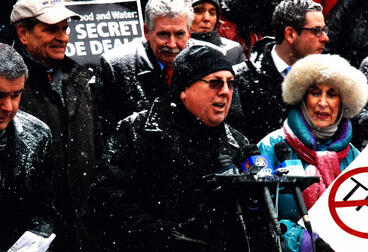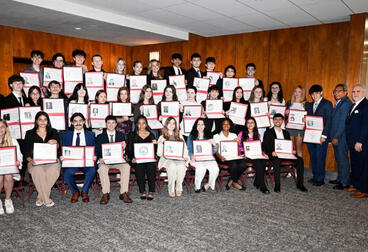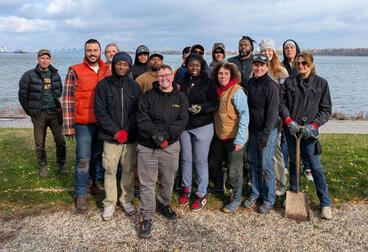“New Year’s is a time to reflect upon the prior twelve months ‰ÛÓ to remember both accomplishments and failures so that lessons may be learned.” These are words printed on the bottom of the front cover of the January, 1986 edition of the Electrical Union World. Reaching back into the history of Local 3, it is clear that the fight of the working men and women of New York remains the same as it was as far back as 1946. Local 3 has been at the forefront of the labor movement as the most progressive and diverse organization that has been both politically involved and socially active in our communities while maintaining electrical jurisdiction over the five boroughs and surrounding areas for the hardworking union tradesmen and women of New York. Local 3 has adhered to its values of integrity, solidarity and helping those less fortunate as Business Manager Harry Van Arsdale Jr. was often quoted as unwavering from these founding principles since the early days.
Scanning the January edition front covers of the Union World every ten years since 1946 demonstrates the ongoing fight for higher wages and benefits through negotiation, the need to raise the minimum wage of all workers, the need to provide each and every electrician with the tools of a higher education, the call of our leadership to continue organizing throughout every facet of our industry and the importance for the membership to stay active in the union and ever-vigilant. These recurring themes throughout our history allow us to remember past accomplishments and offer a chance to evolve and continually grow towards a more perfect tomorrow.
History has shown that the union’s strength is in its ability to collectively bargain on behalf of its thousands of members. As Local 3 gears up in 2016 for contract negotiations, it is important to remember the efforts of all those who came before us. January 1956 front page details the contract negotiations of the dedicated members involved for the Lamp & Shade, M, and DMS Divisions, as well as for the Knight Electric contract. In 1966, the members of the Lamp & Shade Division again aggressively pursued and won a series of wage and benefits increases. The start of 1976 rewarded the efforts of the members of the Elevator division: after an 11-week strike, the membership overwhelmingly ratified a new three-year contract that featured wage boosts, additional holidays and other additional benefits.
The Union World has always been the medium for informing members of theåÊ many happenings of our vast industry. Newly appointed members to Local 3 staff or other positions in the union have all had biographies run in the paper. The new year allows us a chance to be grateful and remember to help those less fortunate. In the January 1966 issue it was reported that Local 3 contributed $500 from the strike fund to help the St. John’s University professors who were removed from their positions for their efforts to have their union recognized. The 1976 front cover’s header reminds us to “Support Labor’s Police Athletic League Fund Drive”, and in 1986 it was reported that apprentices donated 412 pints of blood to area hospital patients. Two traditions that still live on today with yearly blood drives at membership meetings and Local 3’s massive response by its members to aid in the aftermath of Hurricane Sandy electing to give up monies to allocate towards helping people who needed it the most.
Organizing and education have always been two ideas that were at the forefront of Local 3’s mission. More members means more benefits and higher wages. The front cover of January 1966 was headlined by Taxi negotiations starting after winning a second victory as Local 3 sought to bring the drivers into the AFL-CIO. A historic 1966 victory by our membership and leadership got the taxi cab drivers on the road to union representation. Of the 42 garages that held a vote, 28 voted overwhelmingly to join the union, only one voted no union, and the rest of the elections were still pending at the time of print.åÊ
Hand in hand with organizing is the need for continuing education. The goal of Local 3 since the beginning for members to become an educated work force was inspired by longtime Business Manager Harry Van Arsdale Jr. The headline for the January 1946 edition applauds the graduated class of apprentices as they were promoted to receive the valued and respected “A” journeymen card. Well understood by HVA Jr., the importance of education was always paramount in his vision for the members of Local 3 along with the plan for the education of apprentices to be performed by Local 3’s own members. At the bottom of the front page article is a picture of Business Manager Harry Van Arsdale Jr. addressing the graduated class expressing to them their importance as the future of Local 3 and the labor movement. Ten years later, the January 1956 front page article announces the annually renewable Fr. Kelley Scholarship Award applications, already celebrating its 8th anniversary for member’s children who graduate high school to help cover college costs. And the front page article for the January 1956 Union World congratulates 56-year-old member, Irving Basker, for passing his high school equivalency exam proving it is never too late to continue and complete one’s education.
Eventually the Local 3 apprenticeship would be one of the first trade unions to graduate apprentices with an Associate’s
Degree in Labor Studies. Today more and more members of Local 3 continue their studies for a Bachelor’s Degree and further on to graduate work in the Harry Van Arsdale Jr. Center for Labor Studies at SUNY Empire State College. And over 50 years later with many more scholarships offered by Local 3 its members and spouses continue to receive tuition reimbursements to help ease the cost of a college education.
One of the many pressing issues facing our nation today is the need for a decent and substantial minimum wage. Wage fairness and economic injustice are issues that the presidential candidates will increasingly have to address leading up to the presidential election. Incredibly, the same need and fight was being addressed and waged 70-plus years ago as highlighted on the front page of Electrical Union World’s January, 1946 issue: “We want a decent minimum wage and unemployment insurance to protect those unable to find jobs during reconversion.” History has shown that perseverance and persistence in such struggles has and will ultimately lead to victory for the underserved and underprivileged. Congress instituted the minimum wage in 1938 as part of the Fair Labor Standards Act. In his book The Quest for a Living Wage: The History of the Federal Minimum Wage Program, Willis Nordlund, referring to 1946, wrote that, “The 40 cents an hour minimum wage the act now provides is pitifully inadequate in the light of today’s cost of living, and prompt amendment to bring the minimum wage up to at least 65 cents an hour is urgently necessary.” Similarly, President Harry S. Truman in a message to Congress on the State of the Union and the budget for 1947 called for a substantial raise to the minimum wage. He said that, “Lifting the basic minimum wage is necessary,” and that, “it is justified as a matter of simple equity to workers, and it will prove not only feasible but also directly beneficial to the nation’s employers.
On April 15, 2015, “The Fight for $15” took place across the nation and across the world. It highlighted inadequacies in today’s minimum wage. Again, it was a fight for working people and their families for a wage that would help a family meet their basic needs and keep up with the cost of living. Throughout history the fights for civil rights, women’s suffrage, the 10-hour workday were as protracted and grueling as the fight for a fair and substantial minimum wage. But, ultimately, what is fair and right prevailed in those struggles. The war on poverty and the fight for fair wages requires as much perseverance and endurance as the former.
Local 3 members were poised then and are poised now to continue the conversation and the fight for working people both inside and outside of the trade union movement. They are determined to raise the standards for all working people and to continue the fight against income inequality, grotesque greed, a growing wage gap and poverty. As workers persevere and persist, substandard wages and impoverished working men and women will be as foreign an institution and practice as slavery, women not being able to vote or children working 16-hour days in a sweatshop.
Local 3 has always continued efforts in supporting and aiding our military armed forces and its veterans. The January 1946 front cover advertised jobs in the building trades for returning veterans. January 1966 headlines the story of a fourth-year apprentice and Marine Corps Reservist James Walsh raising $300 for homeless citizens in war-torn Vietnam. 1966 also saw the action of Local 3’s Executive Board to compensate any active duty member with a $10 check monthly. The continued tradition of aiding our country’s veterans with the utmost respect continues today possibly stronger than ever before with the Helmets to Hardhats program that brings veterans into the Building Trades.
An article on the front page of January 1986 lays out then-AFL-CIO President Lane Kirkland’s plan for the organization to meet the challenge of the future which includes chronic unemployment, a changing workforce and an increasingly hostile political environment. These words still echo today 30 years later. “Our choice is whether we will be among the victims or among the authors of the events.”
Hope for the future lies in the accomplishments of the past. When the world of today seems increasingly hostile and the outlook is grim, the answers lie in the resilience of Local 3’s past. The fight we are in today is no different than the fight in 1946. We must continue on the path that has led us this far.
Please refer to pages 4-10 to see that the issues we face today have been around for quite some time.
Date Posted


